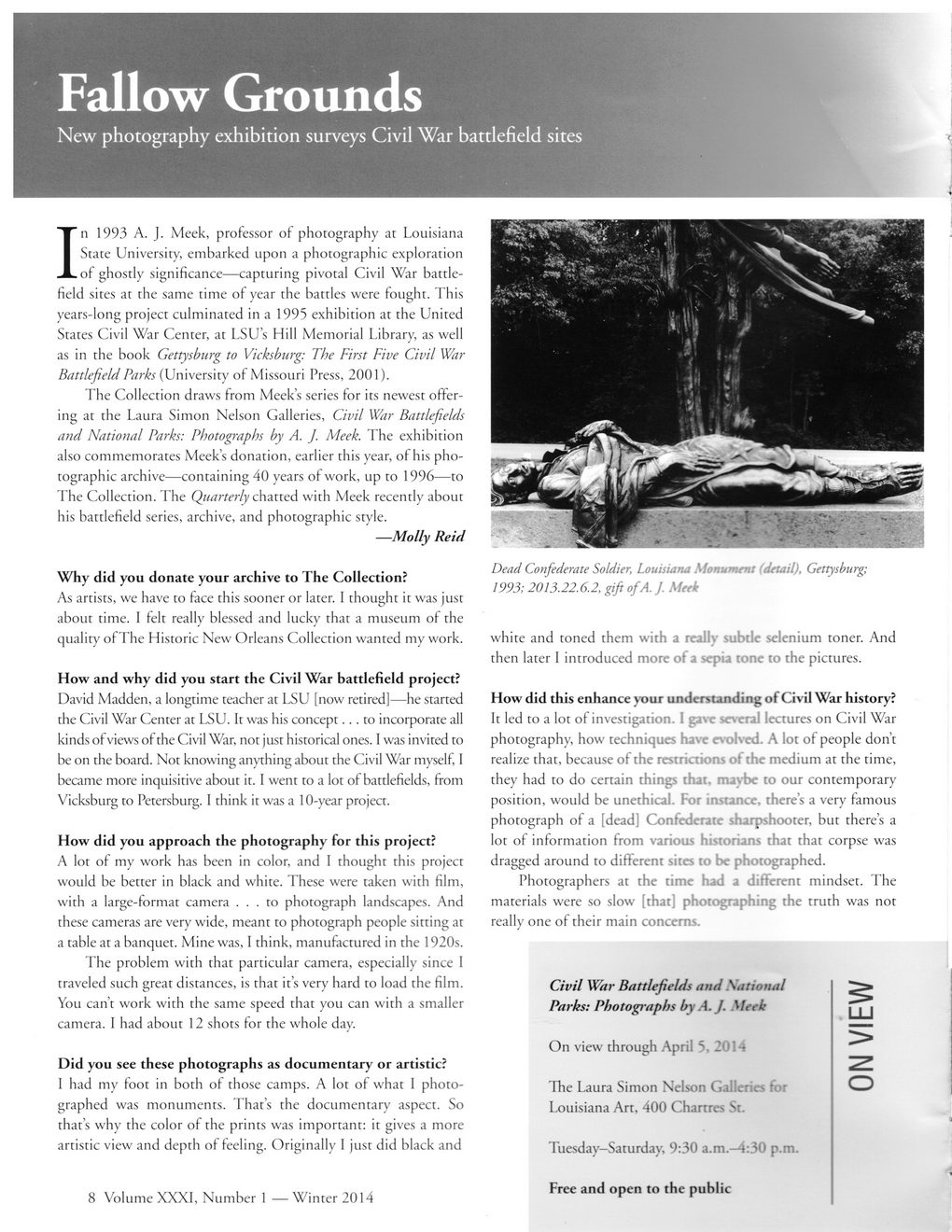This text was obtained via automated optical character recognition.
It has not been edited and may therefore contain several errors.
Fallow Grounds New photography exhibition surveys Civil War battlefield sites I In 1993 A. J. Meek, professor of photography at Louisiana State University, embarked upon a photographic exploration of ghostly significance—capturing pivotal Civil War battlefield sites at the same time of year the battles were fought. This years-long project culminated in a 1995 exhibition at the United States Civil War Center, at LSU’s Hill Memorial Library, as well as in the book Gettysburg to Vicksburg: The First Five Civil War Battlefield Parks (University of Missouri Press, 2001). The Collection draws from Meek’s series for its newest offering at the Laura Simon Nelson Galleries, Civil War Battlefields and National Parks: Photographs by A. J. Meek. The exhibition also commemorates Meek’s donation, earlier this year, of his photographic archive—containing 40 years of work, up to 1996—to The Collection. The Quarterly chatted with Meek recently about his battlefield series, archive, and photographic style. —Molly Reid Why did you donate your archive to The Collection? As artists, we have to face this sooner or later. I thought it was just about time. I felt really blessed and lucky that a museum of the quality ofThe Historic New Orleans Collection wanted my work. How and why did you start the Civil War battlefield project? David Madden, a longtime teacher at LSU [now retired]—he started the Civil War Center at LSU. It was his concept... to incorporate all kinds of views of the Civil War, not just historical ones. I was invited to be on the board. Not knowing anything about the Civil War myself, I became more inquisitive about it. I went to a lot of battlefields, from Vicksburg to Petersburg. I think it was a 10-year project. How did you approach the photography for this project? A lot of my work has been in color, and I thought this project would be better in black and white. These were taken with film, with a large-format camera ... to photograph landscapes. And these cameras are very wide, meant to photograph people sitting at a table at a banquet. Mine was, I think, manufactured in the 1920s. The problem with that particular camera, especially since I traveled such great distances, is that it’s very hard to load the film. You can’t work with the same speed that you can with a smaller camera. I had about 12 shots for the whole day. Did you see these photographs as documentary or artistic? I had my foot in both of those camps. A lot of what I photographed was monuments. That’s the documentary aspect. So that’s why the color of the prints was important: it gives a more artistic view and depth of feeling. Originally I just did black and Dead Confederate Soldier, Louisiana Monument (detail), Gettysburg; 1993; 2013.22.6.2, gift of A. J. Meek white and toned them with a really subtle selenium toner. And then later I introduced more of a sepia tone to the pictures. How did this enhance your understanding of Civil War history? It led to a lot of investigation. I gave several lectures on Civil War photography, how techniques have evolved. A lot of people don’t realize that, because of the restrictions of the medium at the time, they had to do certain things that, maybe to our contemporary position, would be unethical. For instance, there’s a very famous photograph of a [dead] Confederate sharpshooter, but there’s a lot of information from various historians that that corpse was dragged around to different sites to be photographed. Photographers at the time had a different mindset. The materials were so slow [that] photographing the truth was not really one of their main concerns. Civil War Battlefields and National Parks: Photographs by A. J. Meek On view through April 5. 20! • The Laura Simon Nelson Galleries ibr Louisiana Art, 400 Chartres St. Tuesday-Saturday, 9:30 a.m.—4:30 p.m. 8 Volume XXXI, Number 1 — Winter 2014 Free and open to the public

New Orleans Quarterly 2014 Winter (08)